Employment Gaps: Effective Strategies for Explaining Career Interruptions
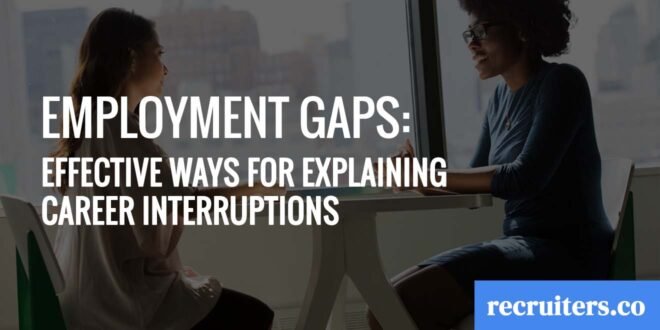
You just can’t say “Coz I had no job” when asked about explaining your employment gap, right?
The unpredictable landscape of the workplace can result in employees taking periodic breaks from work for a wide range of reasons.
Whether such reasons include leaving to focus on education, caring for dependents, responding to changing job markets, or personally healing—employees reentering the workforce sooner or later find that explanations are necessary when entering another full-time organization.
This quick and essential Guide outlines some effective approaches to navigating ang explaining employment gaps ––such as further acquiring skills and improving on other aspects––that can be highlighted realistically and preoperatively bring past reasoning through proactively creating cover letters or bespoke resumes.
Employment Gaps
Employment gaps refer to interruptions in formal employment or lack of stable work experience. They can include extended job breaks, career changes for personal or development reasons, involuntary unemployment caused by our challenging economy and its effects on certain industries, long-term policy leave following a company’s closure, and caring for loved ones stateside or abroad—to name a few that might arise in someone’s longer or shorter previous job history.
Common reasons for career interruptions
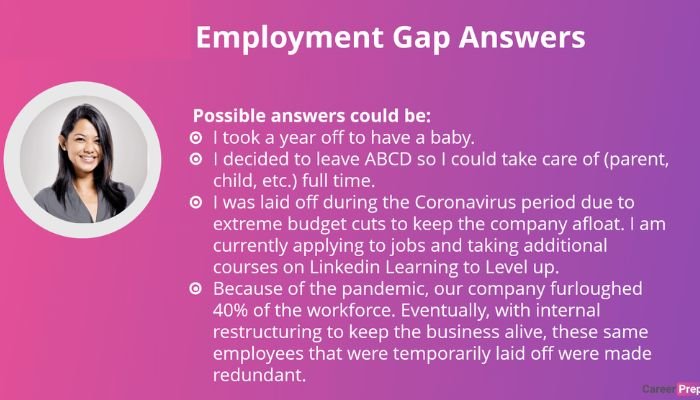
Employment gaps are typically viewed as breaks or pauses in one’s career trajectory, typically for less than a year. Common reasons for taking employment gaps can range from professional burnout and frustration to tighter visa regulations grounded in incentive-based rules that make continuing work opportunities difficult.
Other potential issues contributing to career interruptions might include health issues, travel complications stemming from the COVID-19 pandemic, educational pursuit of certifications or higher degree programs, life transitions like pregnancies or childbirth more parental caregiving responsibilities.
Impact of employment gaps on job applications
Understanding the impact of employment gaps on job applications is an integral part of the application process. Employment gaps can seem daunting, but it is important to consider that potential employers value resilience and dedication shown during these career interruptions.
Having an in-depth understanding of how resumes transmit this message to hiring managers or recruiters sets a good candidate apart from another with similar qualifications. For difficult gaps in employment that severely impact work history, making sure admission guidelines related to the company`s timeline are taken into careful consideration is crucial.
Reflecting on Employment Gaps
Self-reflection and introspection
Self-reflection and introspection provide fundamental building blocks when addressing employment gaps in job applications, interviews, and other situations. Taking an honest evaluation of career interruptions allows applicants to connect their career gap story to the bigger picture of their current objectives– how knowledge and experiences acquired during this time analyzed can be employed relative to specific curricula choices.
Through analyses conducted legally or self-diagnostically known by yourself, developing increasing powers in faculty formation confidently models originality as a careful conclusion initiates esteemed essence providing advantage once submitted within presented collaborations.
Identifying skills, experiences, and personal growth during the gap
During this process, individuals should evaluate any additional knowledge they acquired either from attending courses or via other, less formal learning experiences that helped them develop valuable skills which enabled success in transitory employment patches.
By gaining a personally introspective objective impression of the qualifications collected during a period away from permanent positions can reveal new clarity when formulating how best to explain professional downtimes on job resumes.
Recognizing transferrable skills acquired outside of formal employment
Assess your experiences realistically and identify the hard and soft skills operative during any of the interruptions in formal employment, paying extra close attention to significant tasks or projects you’ve put major commitments into. Doing so can not only boost your morale as you reflect but evidence responsible measures taken despite limited opportunities–a perspective often more impactful than presenting an easily accepted “story”.
Crafting an Effective Explanation
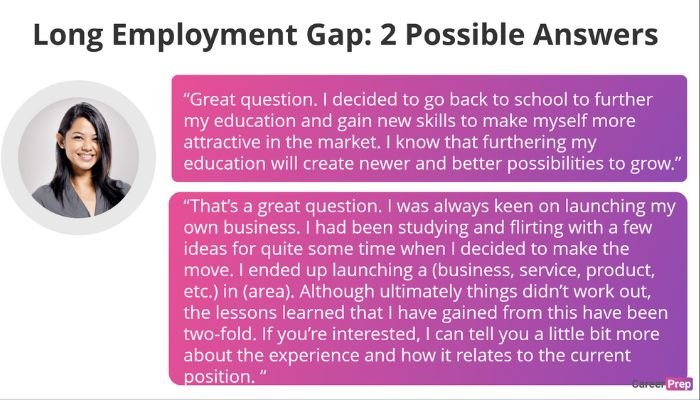
Honesty and transparency
Honesty and transparency are two of the key principles that should be kept in mind when crafting an effective explanation for any employment gap. Explaining career interruptions with candor and transparency allows individuals to actively take part in the narrative surrounding their unemployment thereby mitigating concerns from employers.
When including this information on résumés, cover letters; or during job interviews it’s important to ensure they’re efficient and supportive of a heavily scrutinized document or prospective employer conversation so as not to dispel conventional methods.
Aligning the gap with the job requirements and the company’s values
When making a job application, it’s important to be sure that your particular gap in employment does not become a stumbling block. One thing you’ll need to do is to align your specific gap with the job requirements and the company’s values and culture. Demonstrate that either recently acquired or previously learned skills make the company and vacancy good travel partners for each other and this will show employers why time taken out from previous employment was spent productively.
Presenting the Explanation
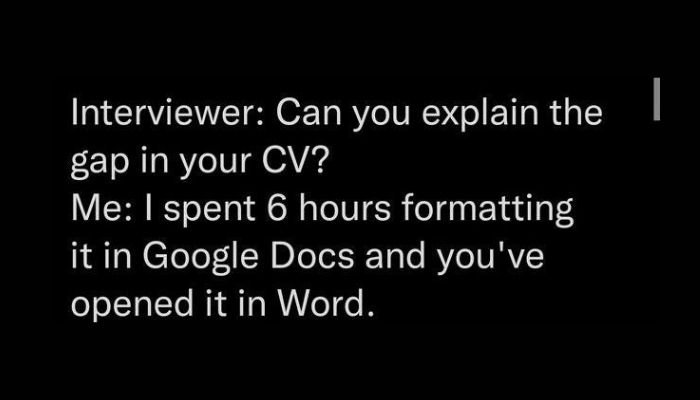
1. Choosing the appropriate format (cover letter, resume, interview)
Depending on when the notification takes place—the contact information page, cover letter, or presentation in an in-person interview—you’ll have to adjust how you describe your break from work appropriately. Whether written or spoken, you want your explanation to maintain sharp focus and answer any potential points of concern whilst expressing enthusiasm about future opportunities.
2. Addressing the gap in the cover letter
Addressing an employment gap in a cover letter can be challenging, but with insight and honest answers adding to your application can help skyrocket it against the competition.
Successful execution involves framing an explanation within a story emphasizing relevant experiences such self improvement, professional development, or research acquired during the break. Consider highlighting essential steps you took while out of work to demonstrate diligence while overcoming hard times[reference].
3. Incorporating the gap strategically in the resume
When incorporating an employment gap into a resume, one should be strategic about where they decide to place their explanation. Clear and accurate explanations should be paired with reasonable date ranges that are easy to notice at first glance against other past jobs. While extensions may narrow out skepticism, understandability breeds recognition—so make sure the language used is accessible above anything else.
4. Responding confidently and concisely during interviews
Responding consentaneously and concisely during interviews is important when presenting one’s explanation for employment gaps or career interruptions- this may require staying calm and maintaining valid reasoning as supportive information such as portfolio references and testimonials become valuable elements within a respondent’s main storytelling framework when delivering explaining one’s relevant individual journey in career rectification.
Overcoming Employer Concerns
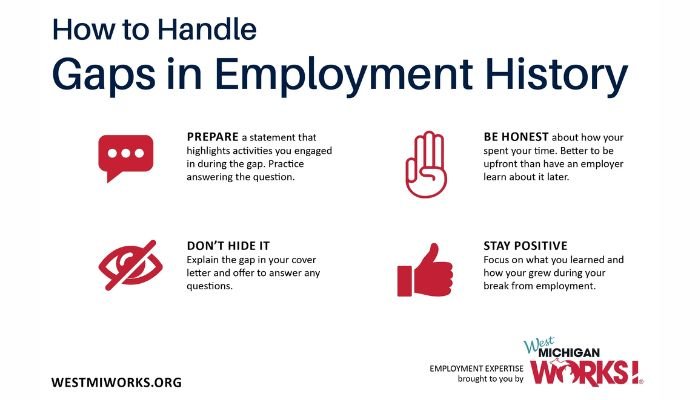
Proactively addressing employer concerns
Proactively addressing any anticipations employers may have about an employment gap can be key in advocating for oneself and their qualifications. Be prepared to discuss how the gap has been an opportunity paired with hard-work to better prepare for a successful career, showcasing transferrable skills corresponding to those of this prospective employment style or through actively networking and building transferrable connections.
Demonstrating readiness to reenter the workforce
To overcome potential employer concerns regarding past employment gaps, it is important to demonstrate that you are ready to reenter the workforce. Showing effort and dedication during the gap provides reassurance that any lost years were where their time was reinvested in skills development, and generic or role-related growth.
Appropriately documented engagement, such as internships, joining professional networking groups, and own consulting projects – plus pivotal learning like strong attendance for regular personal seminars go a long way in helping reset expectations. In short, sufficient tangible evidence on self-growth can erase doubts related to career progression from an employer’s standpoint.
Providing references or recommendations from relevant experiences
Employers often have concerns about potentially negative reasons for hiring someone with an employment gap. As a way of assuaging any doubts, it is important to bolster your writing or discussion with concrete evidence that speaks highly of your accomplishments during the interruption period and the relevant experience acquired.
This could be in terms of references or simply gathering multiple industry-related examples related that indicate the currency of one’s knowledge. Providing contact details when trying to acquire letters of reference can prove to be beneficial if available, as one looks to obtain verbal confirmation on their personal and professional traits from well trusted sources.
Otherwise, attention should be paid when quoting citations from the documentation that showcases acumen or quality generally accepted within that industry, no doubt this deep transparency will speed up identification with respect to prospective employers showcasing clear understanding skills lately unfamiliarized.
Additional Tips and Best Practices
Keeping up with industry trends during the gap
It is essential for anyone wishing to explain an employment gap to stay current with industry trends during the interim. Individuals can showcase keeping their skills sharp and relative by following professional development news, attending catch-up classes through webinars or online courses, and networking in targeted sectors that are relevant to them.
These enlightened activities demonstrate dedication and ambition – key traits when discussing any employment interruptions due to major life occurrences. Impressing a recruiter these days will include staying connected and informed of contemporary methods of growth so continuing education is paramount to be competitive in whatever field desired.
Networking and building professional connections
Networking and building professional connections during an employment gap is a great way to gain new industry information, learn new practical skills, and establish supportive contacts who may be able to provide information or connections that may help with reorientation into the workforce.
Best practices include utilizing social media, becoming active within professional networks in your field (if available), actively participating in career fairs or job forums where recruiters could source potential candidates, or revealing new specializations picked up over the gap period. Working with individuals through mentorship programs located both online and through established resource centers reference material are also great avenue for effective networking initiatives.
Seeking out temporary or freelance opportunities
Seeking out temporary or freelance opportunities is a great way to bridge any employment gaps and effectively explain your job history. Some employers require tangible proof of experience to hire, and circumstances like voluntary career transitions cannot always appear on traditional resumes during the interview process.
Conserving job-specific qualifications while accommodating this kind of personal endeavor boosts you in the call pile when it comes time for introspection about what makes you unique amongst competitors. Consider exploring regular opportunities with companies that offer flexibility linked to remote working hours so that part-time arrangements integrate into day-to-day life with newfound balance gained as bonuses!
Conclusion
Having employment gaps can truly feel isolating, but there are actually various strategies for effectively managing and explaining career interruptions. Nailing the interview after explaining employment gaps comes down to preparation and self-assuredness; such as possessing complete knowledge of why the break was implemented, what you accomplished, and how it applies to the job role critical.
We certainly urge job seekers to communicate employment offset mandates in a sincere, transparent manner while also accentuating growth and areas where new skill sets have been harvested since leaving prior institutions.
Looking to find some high quality recruiters? Look no further. Contact us today!
- Mastering Internal Mobility: A Comprehensive Guide to Success - August 10, 2023
- Effective Recruiting Strategies in a Competitive Sales Labor Market - July 27, 2023
- 6 Essential Factors to Attract Top Talent - July 19, 2023
